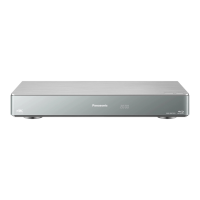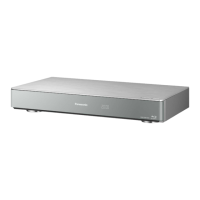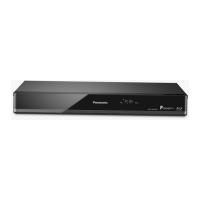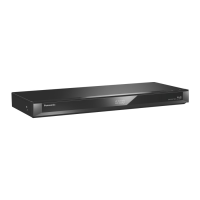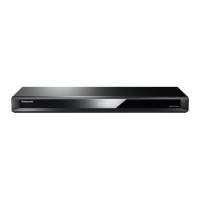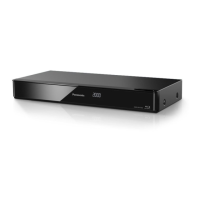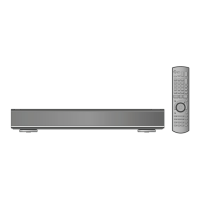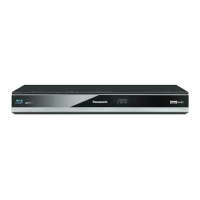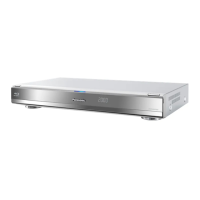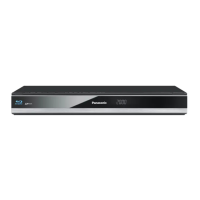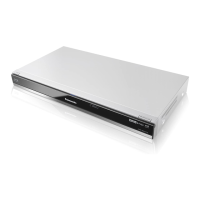Do you have a question about the Panasonic DMR-BWT955GL and is the answer not in the manual?
General guidelines for servicing and safety checks.
Procedure for checking leakage current with the unit unplugged.
Procedure for checking leakage current with the unit powered on.
Techniques to prevent damage from electrostatic discharge to sensitive components.
Safety precautions when handling the laser diode.
Service cautions related to legal restrictions, including lead-free solder.
Information and procedures for using external USB Hard Disk Drives.
Steps for connecting a USB HDD to the unit.
Procedure for safely disconnecting a USB HDD.
Process for registering a USB HDD for use with the unit.
Options for managing USB HDD settings, including deletion.
Procedure to remove all registered USB HDDs.
Special mode registration for USB HDDs used for inspection.
How to check the status of a connected USB HDD.
Formatting procedure for HDD after replacement or error.
Steps to resolve the 'HDD Error' display.
Detailed steps for formatting the HDD.
Using multi-button combinations on the remote for special operations.
Accessing special modes via remote control button combinations.
Procedure to enter Disclosure Mode using remote control.
Procedure to enter Nondisclosure Mode 1 using remote control.
Procedure to enter Nondisclosure Mode 2 using remote control.
Method for checking the micro fuse continuity with a tester.
Checking USB device operation status on the TV monitor.
Procedures for navigating HDD/BD Drive service functions.
Simplified method for checking HDD/BD Drive malfunctions.
Flowchart for quality judgment of the BD Drive.
Simplified method for checking Wi-Fi module malfunctions.
Steps to configure Wireless LAN settings.
How to display the Wireless LAN module version.
Checking the status of the Wireless LAN Module.
Performing inspections using the Tuner Service Mode.
Performing device tests in the Tuner Service Mode.
Displaying accumulated power ON/OFF times.
Procedure for backing up and restoring user settings.
Steps to restore backed-up user settings to the unit.
Details on how to perform and interpret self-diagnosis.
Procedure for checking the diagnostic code on the monitor.
Step-by-step guide to checking the diagnosis code.
Procedure to exit self-diagnosis mode.
Detailed explanation of the self-diagnosis code structure.
Specifications for the unit's power supply.
Details on power consumption in normal and standby modes.
Environmental operating conditions for the unit.
Specifications related to the television tuner system.
Specifications for analog video input connections.
Specifications for analog audio input connections.
Specifications for analog audio output connections.
Specifications for digital audio output connections.
Specifications for the HDMI output.
Capacity of the internal Hard Disk Drive.
Specifications for the USB ports.
Specification for the SD card slot.
Specifications for the LAN Ethernet port.
Specifications for the wireless LAN interface.
Details on the wireless LAN access mode.
Wireless LAN security specifications.
Specifications for recording formats and systems.
Specifications for HD CAMCODER recordings.
Specifications for supported photo file formats.
Specifications for supported video and audio file codecs.
Specifications related to HDMI control functions.
Details on recording times for different media.
Specifications for the unit's laser system.
DVD and BD region code information.
List of supported disc formats.
Specifications for SD card compatibility and formats.
Specifications for USB device compatibility and formats.
Physical dimensions of the unit.
Weight of the unit.
Information about the solder used in the unit.
Identification of controls and indicators on the main unit.
Description of the disc drive mechanism and related components.
Location of the USB memory interface.
Location of the SD card slot.
Instructions for inserting batteries into the remote control.
Procedure for forcibly ejecting a disc when it cannot be ejected normally.
Methods for forcibly ejecting the disc with power on or off.
Steps for forcible disc eject when the unit is off.
Steps for forcible disc eject when the unit is on.
Alternative methods if normal forcible eject fails.
Overview of self-diagnosis and special mode functions.
Detailed information on self-diagnosis error codes and their meanings.
Details on setting various special operational modes.
Procedure to initialize the audiovisual level setting password.
Steps to enter different service modes for maintenance.
Procedure to clean BD-ROM persistent storage history.
Method for forcibly ejecting a disc.
Procedure for forcibly powering off the unit.
Procedure to lock/unlock disc ejection and demonstration.
Initializing progressive settings to interlace.
Procedure to switch the TV system to another region.
Initializing the Deep Colour setting.
Resetting service mode information like error history.
Procedure to display the unit's diagnosis codes.
Overview of available service modes and their functions.
General steps to set up and enter service modes.
How to cancel service mode execution.
Displaying the last error code held by the timer.
Displaying various ROM version information.
Checking if the drive is applicable or not.
Inspecting HDD seek time for performance analysis.
Measuring HDD access time in READ VERIFY mode.
Displaying the accumulated spin-up time of the HDD.
Performing a standard AV scan check on the HDD.
Performing a simple quality judgment of the HDD.
Checking HDD self-diagnosis or BD Drive last error.
Checking the laser used time (in hours) for the drive.
Displaying BD Drive error codes and their meanings.
Judging drive state based on laser power differences.
Checking the CEC terminal high output of HDMI.
Checking the CEC terminal low output of HDMI.
Displaying the date when the unit was produced.
Displaying the unit's stored error history.
Saving error and user operation history to an SD card.
Registering USB HDDs for inspection (special mode).
Inspecting USB HDD seek time for performance analysis.
Measuring USB HDD access time in READ VERIFY mode.
Performing simple AV scan check on USB HDD.
Performing a simple quality judgment of USB HDD.
Testing the repeated opening and closing of the disc tray.
Deleting stored laser used time data.
Deleting last drive error information.
Deleting stored error history information.
Initializing error code information held by the timer.
Initializing service information to factory settings.
Procedure to release from service mode.
Identifying service positions for measurements and adjustments.
Procedure for checking and repairing the Hard Disk Drive.
Procedure for checking and repairing the Blu-ray Disc Drive.
Procedure for checking and repairing the main Printed Circuit Board.
Procedure for checking and repairing the digital Printed Circuit Board.
Tasks required after replacing components like PCBs or HDD.
Important notices after replacing the Digital or BD Drive PCB.
Schematic diagram of the unit's power supply section.
Block diagram illustrating the analog audio and video signal flow.
Block diagram of the analog timer functions.
Block diagram of the digital PCB (part 1).
Block diagram of the digital PCB (part 2).
Block diagram showing the regulator circuits on the digital PCB.
Schematic showing how different PCBs and components are interconnected.
General guidelines for servicing and safety checks.
Procedure for checking leakage current with the unit unplugged.
Procedure for checking leakage current with the unit powered on.
Techniques to prevent damage from electrostatic discharge to sensitive components.
Safety precautions when handling the laser diode.
Service cautions related to legal restrictions, including lead-free solder.
Information and procedures for using external USB Hard Disk Drives.
Steps for connecting a USB HDD to the unit.
Procedure for safely disconnecting a USB HDD.
Process for registering a USB HDD for use with the unit.
Options for managing USB HDD settings, including deletion.
Procedure to remove all registered USB HDDs.
Special mode registration for USB HDDs used for inspection.
How to check the status of a connected USB HDD.
Formatting procedure for HDD after replacement or error.
Steps to resolve the 'HDD Error' display.
Detailed steps for formatting the HDD.
Using multi-button combinations on the remote for special operations.
Accessing special modes via remote control button combinations.
Procedure to enter Disclosure Mode using remote control.
Procedure to enter Nondisclosure Mode 1 using remote control.
Procedure to enter Nondisclosure Mode 2 using remote control.
Method for checking the micro fuse continuity with a tester.
Checking USB device operation status on the TV monitor.
Procedures for navigating HDD/BD Drive service functions.
Simplified method for checking HDD/BD Drive malfunctions.
Flowchart for quality judgment of the BD Drive.
Simplified method for checking Wi-Fi module malfunctions.
Steps to configure Wireless LAN settings.
How to display the Wireless LAN module version.
Checking the status of the Wireless LAN Module.
Performing inspections using the Tuner Service Mode.
Performing device tests in the Tuner Service Mode.
Displaying accumulated power ON/OFF times.
Procedure for backing up and restoring user settings.
Steps to restore backed-up user settings to the unit.
Details on how to perform and interpret self-diagnosis.
Procedure for checking the diagnostic code on the monitor.
Step-by-step guide to checking the diagnosis code.
Procedure to exit self-diagnosis mode.
Detailed explanation of the self-diagnosis code structure.
Specifications for the unit's power supply.
Details on power consumption in normal and standby modes.
Environmental operating conditions for the unit.
Specifications related to the television tuner system.
Specifications for analog video input connections.
Specifications for analog audio input connections.
Specifications for analog audio output connections.
Specifications for digital audio output connections.
Specifications for the HDMI output.
Capacity of the internal Hard Disk Drive.
Specifications for the USB ports.
Specification for the SD card slot.
Specifications for the LAN Ethernet port.
Specifications for the wireless LAN interface.
Details on the wireless LAN access mode.
Wireless LAN security specifications.
Specifications for recording formats and systems.
Specifications for HD CAMCODER recordings.
Specifications for supported photo file formats.
Specifications for supported video and audio file codecs.
Specifications related to HDMI control functions.
Details on recording times for different media.
Specifications for the unit's laser system.
DVD and BD region code information.
List of supported disc formats.
Specifications for SD card compatibility and formats.
Specifications for USB device compatibility and formats.
Physical dimensions of the unit.
Weight of the unit.
Information about the solder used in the unit.
Identification of controls and indicators on the main unit.
Description of the disc drive mechanism and related components.
Location of the USB memory interface.
Location of the SD card slot.
Instructions for inserting batteries into the remote control.
Procedure for forcibly ejecting a disc when it cannot be ejected normally.
Methods for forcibly ejecting the disc with power on or off.
Steps for forcible disc eject when the unit is off.
Steps for forcible disc eject when the unit is on.
Alternative methods if normal forcible eject fails.
Overview of self-diagnosis and special mode functions.
Detailed information on self-diagnosis error codes and their meanings.
Details on setting various special operational modes.
Procedure to initialize the audiovisual level setting password.
Steps to enter different service modes for maintenance.
Procedure to clean BD-ROM persistent storage history.
Method for forcibly ejecting a disc.
Procedure for forcibly powering off the unit.
Procedure to lock/unlock disc ejection and demonstration.
Initializing progressive settings to interlace.
Procedure to switch the TV system to another region.
Initializing the Deep Colour setting.
Resetting service mode information like error history.
Procedure to display the unit's diagnosis codes.
Overview of available service modes and their functions.
General steps to set up and enter service modes.
How to cancel service mode execution.
Displaying the last error code held by the timer.
Displaying various ROM version information.
Checking if the drive is applicable or not.
Inspecting HDD seek time for performance analysis.
Measuring HDD access time in READ VERIFY mode.
Displaying the accumulated spin-up time of the HDD.
Performing a standard AV scan check on the HDD.
Performing a simple quality judgment of the HDD.
Checking HDD self-diagnosis or BD Drive last error.
Checking the laser used time (in hours) for the drive.
Displaying BD Drive error codes and their meanings.
Judging drive state based on laser power differences.
Checking the CEC terminal high output of HDMI.
Checking the CEC terminal low output of HDMI.
Displaying the date when the unit was produced.
Displaying the unit's stored error history.
Saving error and user operation history to an SD card.
Registering USB HDDs for inspection (special mode).
Inspecting USB HDD seek time for performance analysis.
Measuring USB HDD access time in READ VERIFY mode.
Performing simple AV scan check on USB HDD.
Performing a simple quality judgment of USB HDD.
Testing the repeated opening and closing of the disc tray.
Deleting stored laser used time data.
Deleting last drive error information.
Deleting stored error history information.
Initializing error code information held by the timer.
Initializing service information to factory settings.
Procedure to release from service mode.
Identifying service positions for measurements and adjustments.
Procedure for checking and repairing the Hard Disk Drive.
Procedure for checking and repairing the Blu-ray Disc Drive.
Procedure for checking and repairing the main Printed Circuit Board.
Procedure for checking and repairing the digital Printed Circuit Board.
Tasks required after replacing components like PCBs or HDD.
Important notices after replacing the Digital or BD Drive PCB.
Schematic diagram of the unit's power supply section.
Block diagram illustrating the analog audio and video signal flow.
Block diagram of the analog timer functions.
Block diagram of the digital PCB (part 1).
Block diagram of the digital PCB (part 2).
Block diagram showing the regulator circuits on the digital PCB.
Schematic showing how different PCBs and components are interconnected.
| Type | Blu-ray Recorder |
|---|---|
| Storage Capacity | 1TB |
| 3D Playback | Yes |
| Hard Drive Capacity | 1TB |
| Twin Tuner | Yes |
| 4K Upscaling | Yes |
| Wi-Fi | Yes |
| Ethernet Port | Yes |
| DLNA Certified | Yes |
| Recording Format | AVCHD, MPEG-2 |
| Connectivity | Wi-Fi, Ethernet, USB, HDMI |
| Smart Features | Yes |
| Region Code | B |
| Supported Disc Formats | BD-R, BD-RE, DVD-Video, DVD-R, DVD-RW, DVD+R, DVD+RW, CD, CD-R, CD-RW |
| Video Playback Formats | AVCHD, MKV, MP4, MPEG2 |
| Audio Playback Formats | MP3, AAC |
| Output Resolution | 4K |
| Dimensions | 430mm |
| HDMI Output | Yes (x2) |
